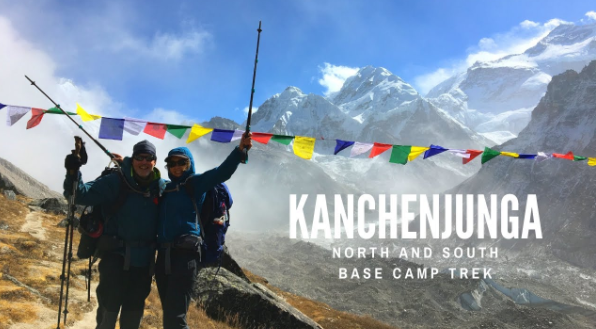The Kanchenjunga Base Camp Trek is one of Nepal’s most remote and spectacular trekking adventures, leading to the foothills of Mount Kanchenjunga (8,586 m)—the world’s third-highest peak. Straddling the eastern border of Nepal and Sikkim, this trek offers breathtaking Himalayan scenery, diverse cultures, pristine wilderness, and a rare sense of isolation.
Unlike the more commercialized routes such as Everest and Annapurna, Kanchenjunga remains untouched by mass tourism, making it perfect for those seeking a raw, authentic Himalayan experience.
Overview of the Kanchenjunga Region
Kanchenjunga, meaning “Five Treasures of the Great Snow,” refers to the mountain’s five majestic summits. The region lies within the Kanchenjunga Conservation Area (KCA), covering 2,035 square kilometers of rich biodiversity—home to snow leopards, red pandas, Himalayan black bears, and countless bird species.
The Kanchenjunga Base Camp Trek offers two main routes:
- North Base Camp (Pangpema) – offering magnificent views of Kanchenjunga’s north face.
- South Base Camp (Yalung Glacier) – known for its stunning glacier and cultural richness.
Many trekkers combine both routes, forming a challenging but rewarding Kanchenjunga Circuit Trek.
Highlights of the Kanchenjunga Base Camp Trek
- Spectacular views of Kanchenjunga (8,586 m), Jannu Himal, and surrounding peaks.
- Explore remote Himalayan villages like Ghunsa, Lhonak, and Ramche.
- Experience unique Tibetan and Limbu cultures, traditional monasteries, and mountain hospitality.
- Encounter pristine forests, glacial valleys, and high mountain passes.
- Trek through Kanchenjunga Conservation Area, a sanctuary for rare wildlife.
- Enjoy the serenity of Nepal’s eastern Himalayas, far from the crowds.
Typical 20-Day Kanchenjunga Base Camp Trek Itinerary
Day 1: Fly from Kathmandu to Bhadrapur, drive to Taplejung (1,820 m).
Day 2: Trek from Taplejung to Mitlung (921 m).
Day 3: Mitlung to Chiruwa (1,270 m), passing through lush valleys and terraced fields.
Day 4: Trek to Sukathum (1,576 m), entering the Kanchenjunga Conservation Area.
Day 5: Climb to Amjilosa (2,308 m), crossing suspension bridges over roaring rivers.
Day 6: Trek to Gyabla (2,730 m), through dense forests of rhododendron and bamboo.
Day 7: Gyabla to Ghunsa (3,595 m), a picturesque Tibetan village.
Day 8: Acclimatization day at Ghunsa; visit a local monastery and explore the surroundings.
Day 9: Trek to Kambachen (4,050 m), enjoying panoramic views of Mount Jannu.
Day 10: Kambachen to Lhonak (4,780 m).
Day 11: Trek to Pangpema (5,143 m) – North Base Camp of Kanchenjunga.
Day 12: Return to Ghunsa.
Day 13: Cross Sele La Pass (4,480 m) to Cheram (3,870 m).
Day 14: Trek to Ramche (4,580 m) – South Base Camp.
Day 15: Explore Yalung Glacier and enjoy stunning views of Kanchenjunga’s south face.
Day 16–19: Descend back through Torongding, Yamphudin, and Khebang.
Day 20: Drive or fly back to Kathmandu.
This itinerary provides a balanced mix of adventure, acclimatization, and cultural discovery while covering both base camps.
Cultural Experience
The Kanchenjunga region is inhabited by diverse ethnic groups such as Limbu, Rai, Sherpa, and Tibetan Buddhists, each preserving their unique traditions.
In villages like Ghunsa and Phale, trekkers witness ancient monasteries, prayer flags, and spinning mani wheels—symbols of Himalayan spirituality. Further down, the Limbu communities display a fascinating blend of animist and Buddhist influences.
The hospitality of locals, coupled with their simple mountain lifestyle, adds warmth and authenticity to the trekking experience. Staying in small teahouses or family-run lodges allows visitors to connect with local culture while supporting sustainable tourism.
Scenic Beauty and Natural Diversity
Few treks in the world can match the scenic diversity of the Kanchenjunga Base Camp Trek. The journey begins through lush lowlands filled with rice terraces and cardamom plantations, gradually ascending into dense forests of oak, pine, and rhododendron.
Higher up, the vegetation gives way to alpine meadows and glacial moraines. The towering peaks of Kanchenjunga, Jannu, and Tent Peak dominate the skyline, providing stunning photo opportunities.
The Yalung Glacier and Pangpema viewpoint offer some of the most breathtaking panoramas in the Himalayas—vast expanses of snow, ice, and towering cliffs.
Wildlife enthusiasts may spot rare animals like red pandas, blue sheep, and Himalayan monals. The region’s isolation helps preserve its pristine environment, making every moment feel pure and unspoiled.
Difficulty Level and Physical Preparation
The Kanchenjunga Base Camp Trek is considered strenuous due to its remote trails, long walking hours, and high altitudes exceeding 5,000 meters. It requires excellent physical fitness, mental endurance, and prior trekking experience at altitude.
There are no technical climbs, but trekkers face rugged paths, steep ascents, and limited facilities. Adequate acclimatization, hydration, and gradual ascent are essential to avoid altitude sickness.
Training with regular hiking, cardio workouts, and strength exercises before your trip will make the journey smoother and more enjoyable.
Permits and Regulations
As the region lies within a restricted zone, several permits are required for the Kanchenjunga Base Camp Trek:
- Restricted Area Permit (RAP): Issued only through government-registered agencies.
- Kanchenjunga Conservation Area Permit (KCAP): Required to enter the conservation area.
- Trekkers’ Information Management System (TIMS) card.
Solo trekking is not allowed in Kanchenjunga. Trekkers must be part of a group with a licensed guide and a minimum of two people.
Accommodation and Food
Accommodation on the Kanchenjunga Base Camp Trek is mostly in basic teahouses, though camping treks are also possible. The lodges are simple but cozy, offering clean rooms and hearty home-cooked meals.
Typical dishes include dal bhat (rice and lentils), noodles, potatoes, and occasionally yak cheese. As you climb higher, the availability of fresh food decreases, so flexibility is key. Despite the simplicity, the warmth and hospitality of local hosts make every stay memorable.
Best Time to Trek Kanchenjunga
The best seasons for the Kanchenjunga Base Camp Trek are spring (March–May) and autumn (September–November).
- Spring: Rhododendron forests bloom, and the weather is clear and mild.
- Autumn: Offers excellent visibility and stable conditions for trekking.
- Winter (Dec–Feb): Extremely cold and snowy—recommended only for experienced trekkers.
- Monsoon (Jun–Aug): Trails are slippery, though the region remains lush and green.
How to Reach the Starting Point
The trek begins from Taplejung, which can be reached by flying from Kathmandu to Bhadrapur, then driving to Taplejung via Ilam. Alternatively, there are long overland routes from Kathmandu, though they can take several days.
Most trekking agencies organize the transportation logistics, including local flights and permits, making the journey smoother.
Why Choose the Kanchenjunga Base Camp Trek?
- Off-the-beaten-path experience: Fewer trekkers, more solitude, and pure wilderness.
- Untouched culture: Traditional mountain life unchanged for generations.
- Dramatic scenery: Towering peaks, glaciers, and alpine valleys.
- Adventure challenge: Demanding trails for serious trekkers.
- Ecological diversity: Rich flora and fauna within a protected area.
If you seek a trek that challenges your limits and rewards you with raw natural beauty, this journey is unparalleled.
Responsible Trekking and Sustainability
The Kanchenjunga region is fragile and remote. Trekkers are encouraged to follow Leave No Trace principles—dispose of waste properly, respect local customs, and support eco-friendly lodges.
Using local guides and porters ensures the community benefits from tourism, helping preserve this beautiful yet delicate environment.
Conclusion
The Kanchenjunga Base Camp Trek is a journey to one of Nepal’s most secluded and awe-inspiring destinations. It’s not just about reaching the base camp—it’s about immersing yourself in the rhythm of remote mountain life, walking through unspoiled landscapes, and standing beneath one of the world’s greatest peaks.
For trekkers who crave adventure beyond the beaten trails and yearn for a genuine Himalayan experience, Kanchenjunga offers the perfect blend of challenge, serenity, and discovery.


